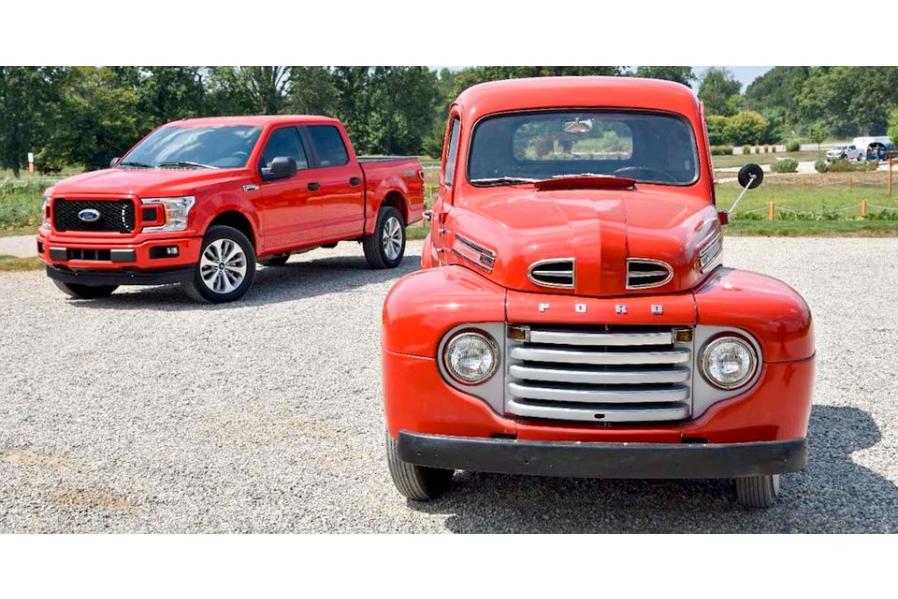Blog Posts

20 Photos Of How The Ford F-Series Has Changed Over The Years
20 Photos Of How The Ford F-Series Has Changed Over The Years
Not many car series can say they’ve had 13 generations. The F-Series is still going strong today and has changed dramatically over the years.
- Mar 31, 2020
The Ford F-Series is literally Ford’s saving grace right now – their ace in the hole. It’s been the best-selling vehicle in the U.S. for 38 years, year in and year out. At a time when Ford is trying to figure out its identity, cutting all of their sedan and car lines except for the Mustang, switching to SUVs and crossovers… the F-Series remains strong.
But the truck comes from humble beginnings. Ford is, after all, the company that brought us the Model T, which put America on wheels. Then the Model TT with a pickup truck bed came out and stunned everyone in the 1910s and ‘20s. It wasn’t until after World War II that the F-Series would finally be introduced.
And they quickly had a winner on their hands. Every year the truck seems to sell better than the last, and it’s now reaching the tail-end of its 13th generation. Not many car series can say they’ve had 13 generations!
20 First Gen: F-Series Bonus Built (1948-52)
Following the first truck in the U.S., the Model TT, Ford sold 4 million Model 50 pickups from 1935-1941. Then WWII hit. Following the comedown of the war, Ford repositioned their resources from wartime to peacetime, and introduced the first-gen F-Series in 1948, known as the F-Series Bonus Built trucks. They ranged in size and capability, from half-ton F-1 to cab-over F-8, and everywhere in between.
19 Second Gen: The F-1 Becomes The F-100 (1953-56)
Starting in 1953, the new second-gen Ford F-Series was released. It only lasted for four short years, and adopted a new naming system: the F-1 became the F-100, the F-2 and F-3 were consolidated into F-250, and the F-4 became the F-350.
The classic vintage look of the truck is what’s most remembered. In ’54, the legendary flathead V8 was replaced by an overhead-valve-eight, and heavier-duty trucks were also created in a new commercial-truck division from Ford.
18 Third Gen: All New Styling (1957-60)
The third generation of the F-Series brought some major stylistic changes to the truck’s interior, with the first hint of a wider, squared-off style that it would become known for later. Up until this point, the F-Series was defined by an almost “bubbled” look, kind of like the cartoons you see in Cars, the animated movie. Also, in 1959 the first four-wheel-drive option became available.
17 Fourth Gen: “Drives Like A Car, Works Like A Truck” (1961-66)
Up until 1965, the F-Series used a traditional solid-axle suspension, but that changed when Ford introduced the twin-I-beam setup. This came four years into the fourth generation’s reign, near the tail-end of it.
The new suspension was available on two-wheel-drive models and was for noncommercial truck users, with the slogan: “Drives like a car, works like a truck.” In ’65, the first factory-built four-door crew cab became available. The top-trim Ranger appeared in ’66.
16 Fifth Gen: Improved Exterior All Around (1967-72)
The fifth-gen F-Series, introduced in 1967, was starting to show the style that would remain with the pickup series for the next two decades. “FORD” was spelled out in big block letters on the hood, it had an improved cab with four inches of more shoulder room, and the grille sported integrated headlights for the first time.
15 Sixth Gen: Introduction Of The F-150 (1973-79)
The sixth gen had few noticeable changes to the fifth, but it did come with new parking lamps above the headlights, a concave groove along the side, and a redesigned grille. Also, the Club Cab arrived in ’74, and the biggest news of all, the F-150 first appeared in ’75. It would surpass the F-100 in popularity soon, but the F-100 stuck around until 1983. Rectangular headlights were first offered on upper-trim trucks in ’78, and became factory-standard in ’79.
14 Seventh Gen: “The First New Truck Of The 1980s” (1980-86)
Ford called the seventh-gen F-Series: “The first new truck of the 1980s.” Rather than massive exterior redesigns, it was focused on a plusher interior and improved aerodynamics. Starting in ’83, the F-150 passed the F-100 as the base F-Series model. To help fuel efficiency, Ford dropped the M-Series engines in ’81 (5.8- and 6.6-liter V8s) and replaced them with a 4.2-liter 255CI and 5.8-liter 351CI Windsor V8.
13 Eighth Gen: Mild Refreshment, But With Fuel Injection (1987-91)
The eighth-generation F-Series, introduced in 1987, had a mild refresh with a new flat grille and headlights, rounded wheel arches, and power steering and brakes, plus rear anti-lock braking. The base 300CI six-cylinder got fuel injection for the first time, pumping its horsepower from 117 to 145 and 265 lb-ft of torque. That made it just 5 lb-ft short of the 5.0-liter V8.
12 Eighth Gen: Nite Edition Introduced In 1991
Ford finally wanted to add some pep to their mundane F-Series lineup, so they introduced the Nite Edition in 1991. It came only as a regular cab truck, but with four-wheel drive. It was an XLT Lariat trim available only in black with blacked-out everything (except the little side racing stripe). The 5.0-liter V8 was standard, but the 351 Window was available as an upgrade.
11 Ninth Gen: Officially The World’s Best-Selling Vehicle (1992-96)
The ninth-gen F-Series could be considered “softer,” with an even more aerodynamic fascia and hood. The Nite Edition returned again, and in 1995 the F-Series passed up the Volkswagen Beetle as the world’s best-selling vehicle, making history. The Beetle retained the record for passenger cars, but no one has been able to keep up with the F-Series since ’95, 25 long years ago.
10 Ninth Gen: The Insane 1993 F-150 SVT Lightning
Urged by the success of the Nite Edition, Ford released the monstrous F-150 SVT Lightning in 1993. Available only as a single-cab, short-box truck, in black or red (white was added in 1994), it incorporated a 5.8-liter V8 engine with 240 hp and 340 lb-ft of torque, with a four-speed automatic transmission. It had a 110-mph top speed and is a collectible car today because only 11,563 were produced between 1993-95.
9 10th Gen: Most Dramatic Redesign In A Decade (1997-2003)
The 10th-gen F-Series was unveiled at the 1996 Detroit Auto Show. It featured the most dramatic changes in over a decade, with a shift to casual users for the F-150. The F-250 and F-350 Super Duty remained for commercial and heavy haulers. The F-150 of the early 21st century was sleek, aerodynamic, and had a lighter chassis that got rid of the iconic twin-I-beam suspension in favor of a torsion-bar setup.
8 10th Gen: The Most Powerful Production Vehicle: 2001 SVT Lightning
The SVT Lightning made a triumphant return in 1999, but it really hit it out of the park in 2001. With 380 hp and 450 lb-ft of torque, this was the most powerful production passenger vehicle sold in the US at the time! Car and Driver tested it and saw it could reach 0-60 mph in 5.2 seconds and had a 142-mph top speed. It’s still considered one of the best performance pickups of all time.
7 11th Gen: Larger And More User-Friendly (2004-08)
Ford started to move closer to user-friendliness with the 11th-gen F-Series introduced in 2004. It was larger, more comfortable, and featured a SuperCab (extended cab) variation with more storage and passenger room.
This truck showed that normal everyday people – not just workers – were starting to buy the F-Series in droves. Annual sales of the F-Series reached an all-time high of 939,511 during this time, with the Super Duty included in that.
6 12th Gen: More Aggressive, Plus The Platinum Trim (2009-2014)
The 12th-generation F-Series was popular, but the Super Duty was even more popular, and the 12th-gen took advantage of that. The F-150 was redesigned to resemble the Super Duty, with a more prominent grille, aggressive headlights, and a squared styling. It had a new, fully boxed frame for improved torsional rigidity, and engines were upgraded.
In 2011, the turbo 3.5-liter EcoBoost V6 was introduced, and the Platinum trim also made an entrance for the first time, for luxury users.
5 12th Gen: 2010 F-150 SVT Raptor Changed The Whole Truck World
The coolest thing out of the 12th-gen F-Series was the introduction of the first-gen, 2010 F-150 SVT Raptor. It flipped the whole truck world on its head, with its rugged looks, its off-road long-travel suspension, its cast-aluminum lower arms and Fox Shox Racing dampers.
Using a 320-hp 390-lb-ft SOHC 5.4-liter V8, it was awesome. But with the V8 that came later, it became a monster with 411 hp and 434 lb-ft of torque.
4 12th Gen: A New Heavyweight, The 2014 F-150 Tremor
At the tail-end of the 12th generation came the F-Series Tremor. This special-edition, all-aluminum bodied 2015 model used Ford’s 3.5-liter EcoBoost V6 with twin-turbo, rather than the V8. It was a regular-cab with an awesome graphics package, and buyers could choose between rear- and four-wheel drive, with a 20-inch set of Pirelli Scorpion rims to go along with it.
3 13th Gen: Radical Changes When They Didn’t Have To (2015-Present)
Ford literally didn’t need to change their F-Series at all with the new generation, and people would still flock to it. But they did, giving it a new aluminum “beer can” body atop the steel frame. It was lighter, more rust resistant, and was the first pickup truck to earn a five-star NHSTA safety rating! Needless to say, it still remains the best-selling car in the U.S.
2 13th Gen: The Most Beastly F-150, The 2017 Raptor 2.0
The most exciting new trim came in 2017 with the Raptor 2.0, which somehow outdid its predecessor. Sporting a 510-hp twin-turbo EcoBoost V6, it was literally capable of jumping over dunes.
The off-road animal was also a fully functioning daily driver that people loved, and could reach 40,000 miles without any problems, according to a Car and Driver test. This truck remains our favorite F-Series. In 2019, the Ranger Raptor was introduced as a smaller brother to the Raptor.
1 The Future: Going Electric
What does the future of the F-Series look like? Unsurprisingly, it looks electric. Ford has promised to release an all-electric F-150 in the future, probably in 2021 or 2022. While petrol purists are up in arms about it, it’s hard not to raise your eyebrows when you see an electric F-150 tow a train that weighs over 1 million pounds!
The future looks bright for this vehicle, no matter what Ford does. It’s literally the company’s saving grace right now.


